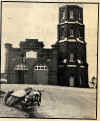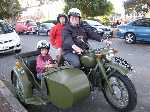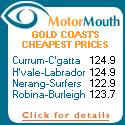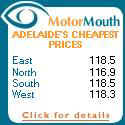The Diary of an Enthusiast
- as originally published in TwoWheels magazine April 1973
As read by OCR from scanned copy. All photographs have been reduced to thumbnail size. Click on the thumbnails to see each photograph in full size.
How else could you describe the experiences of a man who has ridden 300,000 miles throughout Australia — and most of that on outfits — in any other way than . . .
The diary of an
enthusiast
They’ve known him at the Kangaroo Rally since '66, at the Southern Cross Rally he's taken the "Greatest Outfit Distance" award several years running. He's attended the Alpine and Maryborough Vintage rallies, has won successive awards as the most conscientious motorcyclist of his local Ballarat Rovers club, and has a pile of engraved testimonials to his prowess in navigation trials, sports days and scrambling.
At 26, rotund, genial, bearded Victorian schoolteacher PHIL SMITH has put a lot of miles behind him, regards three wheels as superior to two, and has a great many more miles in front of him — on a recently bought Guzzi 850.
But he didn't always have the first and most expensive bike of its kind in Australia. Here’s Phil with his story — one which distinguishes him as outfit rider supreme and one of Australia’s most travelled motorcyclists.
 This photo is stitched together from a photo split between pages 52 and
53 of TwoWheels magazine April 1973 issue. Taken at the Southern Cross Rally in
1970, it shows the author seated on his 1969 Triumph Trophy TR6 bike with a beautifully
restored 1946 Dusting sidecar.
This photo is stitched together from a photo split between pages 52 and
53 of TwoWheels magazine April 1973 issue. Taken at the Southern Cross Rally in
1970, it shows the author seated on his 1969 Triumph Trophy TR6 bike with a beautifully
restored 1946 Dusting sidecar.
PHIL SMITH started riding motor- cycles in a paddock at Tyers in Gippsland on Sunday, June 13; 1964.
Three days later he obtained his Learner‘s Permit and ventured forth on to the road. The mount was a 1951 sidevalve 250 cc BSA (Model C10), registered number DA690, which, with the help of a tail wind, was able to attain the magnificent speed of 45 mph (although there was no speedo to convey that fact to the rider).
Before getting the Beeza, Phil had yearned for a car — "motor- cycles are dirty, noisy, dangerous two-wheeled coffins" — but father knew best, and insisted that Phil ride a motorcycle for a year or so to learn some road sense.
That car Phil had wanted so badly for so long has not yet been bought — more than eight years later.
The Beeza, a rigid-frarned monstrosity for which Phil paid $80, had a habit of blowing up after every few days of riding and then taking a week or two to repair.
One cold October Friday, before leaving for work, Phil kicked the old girl to get her started and suddenly felt warmer than even that exercise should have made him, the carby was on fire!
After a combined family effort to shovel the vegetable garden on to the bike, the flames were finally put out 20 minutes after the start of the fire. But what a sad and sorry sight the bike looked!
With six months of Beeza-style motorcycling behind him, Phil felt that a change was needed.
 The author’s most faithful outfit — the Yamaha RT1 with
Tilbrook sidecar. This shot was taken at Mt Hotham, Victoria, about 6000 ft above sea
level.
The author’s most faithful outfit — the Yamaha RT1 with
Tilbrook sidecar. This shot was taken at Mt Hotham, Victoria, about 6000 ft above sea
level.
On December 14, 1964 he took delivery of his first brand-new motorcycle. It was a shiny blue 125 cc Yamaha YA6, registered number DC895, and was probably one of the first autolube-fitted Yamahas to come to Australia. This machine, which cost $430, was capable of just over 70 mph, but seemed happiest if cruised at 45·50. Plastic leg-shields were fitted as standard equipment while 12 volt electrics, electric starter, and turn- ing indicators were the features (then) that really opened the eyes of other motorcyclists.
Lesson No. 1 was learned when the little Yammy was only five days old. While cornering at excessive speed the back wheel slid out on some loose gravel, but fortunately all that was hurt was the rider’s pride.
During 1965, Phil’s family moved to Ballarat and it was then necessary for him to take up long-distance touring. The little 125 made the 350-mile trek to visit the folks nearly every weekend. During the year it chewed holes in three pistons and had one main bearing replaced. It also used seven spark plugs in running up the 15,000 miles which it had completed by February 1, 1966, when it was traded in on a 250 cc Yamaha YDS3, registered number DH528, which cost $559.
The spark plugs with which the bike had been fitted when brand new were not removed until four months later when the bike had covered 6,085.1 miles. Throughout the whole life of the bike, plugs needed to be replaced only at intervals of about 5,000-6,000 miles and decarbonising was done at similar intervals.
 The next machine, a 250 Yamaha, in solo trim — and cold going!
The next machine, a 250 Yamaha, in solo trim — and cold going!
After exactly one year the Yamaha had covered 14,308.5 miles at an average cost of 3.81 cents per mile. (This cost, however, included buying such accessories as pannier bags, fibreglass Dolphin fairing, crash bars and smaller bits.) Average petrol consumption for the year was 51.96 miles a gallon and the petrol/oil ratio worked out to 32.4:1.
The second full year of operation saw the speedo reach 31,297.1. A total of 16,988.6 miles had been covered at an average cost of 2.91 cents per mile. (Fewer accessories were bought that year.) The fuel consumption was 49.89 miles a gallon and the petrol/oil ratio was 43.94:1. (The oil pump adjustment had been cut right back to avoid excessive smoking from the exhausts.)
lt was during the third year that the greatest change was made to the bike. Phil’s mate, Alwyn Sobey, seemed to be getting so much enjoyment from riding his BMW outfit around that the Yammy simply had to sprout a third wheel. In May, 1968, when the speedo read 37,490.3 miles, a Dusting sidecar chassis was fitted at Pratt and Osborne Motors, Geelong.
Now fitting a sidecar is one thing . . . learning to ride it is a different matter altogether. The Eastern Gardens at Geelong have never been quite the same since that fine May morning when Phil, armed with his new toy, mowed down flower beds, shrubbery, and anything else that couldn’t get out of the way quickly enough, as he vainly battled to control this wild three-wheeled monstrosity which seemed to have a mind of its own. But he mastered it!
 Taken a few months later. The bike was equipped with a Dusting chair
that paved the way to Phil's prolonged sidecar interest. This
photo was taken opposite the Ballarat Fire Station, that magificent brick building with
the imposing tower that you see in the background.
Taken a few months later. The bike was equipped with a Dusting chair
that paved the way to Phil's prolonged sidecar interest. This
photo was taken opposite the Ballarat Fire Station, that magificent brick building with
the imposing tower that you see in the background.
Many miles of sidecar hauling soon started to tell on the little 250, and on October 12, 1968, the first engine repairs were needed — at a speedo reading of 44,369.8 miles. The cylinders were bored and new pistons, rings, small-end bearings, circlips, head gaskets, base gaskets, and exhaust pipe gaskets were fitted. This was the first time that any of these components had been replaced. Total cost of this overhaul, including labour, was $56.56.
With the sidecar attached, the average fuel consumption dropped to 38.99 miles per gallon and the cruising speed dropped from 65-70 mph down to 50-55 mph. The petrol/oil ratio, however, remained at 37.22:1.
 An outfit to the rescue.
An outfit to the rescue.
Bridgestone at left did many miles in the chair after Phil encountered its owner pushing
it along a lonely stretch of highway in East Gippsland. It was repaired at a garage in
Orbost, Victoria. Note the "Flying Fish Box" replacing the normal streamlined
body on the Dusting sidecar chassis.
On October 31, 1968, the speedo blew up with a reading of 45,458.5 fixed on its dial. Apart from the speedo, all went well with the Yamaha.
But in January, 1969, Phil made what he regards as the worst mistake of his motorcycling career. He traded in the trusty Yamaha, which had served him obediently for 60,000 trouble-free miles, on a brand new 650 cc Triumph Trophy TR6, registered number DS792, which cost $1352, including insurance and registration.
 In ’69 Phil went British, but his new TR6 was a sad mistake.
Photo taken beside our home in Commercial Road, Morwell. Sidecar passenger is my
sister Karen.
In ’69 Phil went British, but his new TR6 was a sad mistake.
Photo taken beside our home in Commercial Road, Morwell. Sidecar passenger is my
sister Karen.
The theory behind this exchange was that as the Yamaha was becoming a little long in the tooth and it was anticipated that weekly mileage would continue to exceed 400 miles, it was time to obtain a reliable machine . . .
On the 14th day of ownership the Triumph was immobile. Investigation revealed that a rebore was necessary, although a mere 3,301 miles had been covered, The rebore put the bike off the road for three weeks because of a shortage of oversize pistons.
The outfit was then ridden for another 14 days before the motor again slowed down and came to a standstill. On this occasion, at a speedo reading of 6,011 miles, the motor had to be re-sleeved back to standard. It was too worn to be rebored!
By the time the outfit had covered 25,000 miles (one year), the motor contained the sixth cylinder sleeve, 12th piston, fourth main bearing, and third primary chain, not to mention many gearbox parts that had been replaced during the same period.
Dozens of spokes had been broken and replaced in the rear wheel (Phil soon learned not to venture too far from home without a couple of dozen spokes in the boot of the sidecar), and countless nuts and bolts had rattled off and been replaced. Dozens of small parts, such as muffler brackets and the like had been welded up after having broken and the bike had been off the road awaiting parts and repairs for more than half the time.
Repairs and running costs during the year totalled more than $1,200 dollars and, as the trade-in value was only $500, the year’s transport had worked out to be rather expensive — about $2,500 for 25,000 miles, or about 10 cents per mile. The bike had not been thrashed, as it was never cruised at much more than about 50-60 mph.
Phil persevered with the Triumph until March, 1970, when he traded it in on a Suzuki B100P.
A fortnight later the little Suzuki was traded in on a 196 cc Suzuki T200 with a Watsonian Bambini sidecar — both brand new.
 After the Triumph Phil went "chair" again on this T200
Suzuki with Watsonian Bambini sidecar. Photo was taken in 1970 on the ovals at the
Township of Yallourn, which in 2010 is now sadly non-existent. This photo was first
published in the Latrobe Valley Express.
After the Triumph Phil went "chair" again on this T200
Suzuki with Watsonian Bambini sidecar. Photo was taken in 1970 on the ovals at the
Township of Yallourn, which in 2010 is now sadly non-existent. This photo was first
published in the Latrobe Valley Express.
The comfort of this sidecar had to be experienced to be believed. The well-damped swinging arm suspension of the chassis together with the deep, soft, innerspring cushions of the seat and backrest assured the passenger of a comfortable ride, while the carpeted floor and beautifully upholstered interior added that extra touch of luxury. The wide wrap-around, Perspex windscreen set into the lightweight fibreglass bodywork allowed excellent vision, while the waterproof fabric hood kept the rain off, The hood and hood bows could be stowed away in a pouch behind the seat for fair weather motorcycling.
Handling of the little Suzuki outfit was perfect, although the sprung sidecar wheel took some getting used to after the rigid-framed Dusting.
If the handlebars were let go on a road of normal camber the outfit would follow a perfectly straight track without any sign of the wobbles and shakes for which some of the older outfits were notorious.
The Bambini was mounted to the Suzuki by a single, large-diameter mounting tube which was welded to a subframe which was bolted to the bike frame at four points, all hidden out of sight under the motor and gearbox, an arrangement which made for a very neat outfit.
While the outfit handled and performed perfectly with this single mounting, the sidecar chassis was prone to a slight flexing when a heavy load was carried in the very spacious boot. To correct this a ½ -inch diameter bracing tube was run from the carrying rack mounting lug to the rear of the sidecar chassis. This made the outfit so sturdy that, with the body replaced by a fish-box, it was raced against scramble outfits at sports days and similar events.
After careful running in at 40-45 mph, the outfit was cruised at about 60 mph and ran smoothly up to its top speed of about 70 mph. On one occasion, on a long downhill straight, with a strong tailwind blowing, the outfit reached 95 mph (with a corresponding tacho reading of "Made in Japan" — at least it was no longer in the red!). At this speed vibration was excessive!
With an adult on the pillion seat and two children in the sidecar, the cruising speed dropped to 45-50 mph, which is all that one requires for normal short-distance transport.
Mechanically, this outfit was trouble-free (except for the speedo going on the blink) until about 7,000 miles, when nasty noises were heard from the crankcase.
Fearing all sorts of expensive possibilities, Phil split the cases. The trouble was instantly obvious —- the oilway to lubricate the centre main bearing had been cleanly drilled in both halves of the casing, but the necessary hole had not been punched in the gasket between them. At least 7000 miles without lubrication demonstrated the high quality of Japanese bearings.
While awaiting the new main bearing (it had to come from Japan, and took seven months). Phil was forced to sell the sidecar to buy a bike to ride to work. The bike he bought was a 250 cc Yamaha DT1 and with this he took up trail riding.
The trail-riding business was all very enjoyable, but it wasn’t very long before Phil found himself being bitten by the sidecar bug again. Just before Christmas, 1970, the rusting remains of a Tilbrook Tom Thumb sidecar, together with a brace of broken Vespas, was bought for $20. The sidecar was restored and fitted to the Yammy and, for the second time in his motorcycling career, Phil found himself the proud owner of a 250 cc Yamaha outfit.
After the annual pilgrimage to the Southern Cross rally it was time to try out three-wheeled trail riding, so Phil set out with several members of the Bairnsdale and District Motor Cycle Club to follow the old packhorse trail from Seldom Seen (an aptly named place, if ever there was one) to Dargo in the Victorian Alps. After bouncing over boulders, ricocheting off rocks, stacking into stumps, charging through channels, and roaring through rivers, the outfit showed no signs of damage in spite of its rather cruel knocking about.
In one section this trail consists of a 6ft wide ledge cut into the nearly vertical side of the mountain. On rounding a convex curve in the mountainside, it was found that the ledge had been narrowed down to a width of only 2 ft by a recent landslide. No sweat! Phil merely lifted the sidecar wheel and kept right on riding on the two wheels of the bike with the sidecar hanging out in mid-air, about 200 feet above the river. The Bairnsdale boys still discuss that episode!
Reliability is the most important factor to consider if one wishes to enjoy riding a bike, and the DT1 outfit certainly had it, Apart from the normal consumable items, such as tyres, chains and bulbs, the only parts needed were a set of rear wheel bearings (too many creek crossings, perhaps) and a rebore (after 20,000-odd miles of severe thrashing).
Phil usually rode the DT1 absolutely flat-out everywhere and this produced a top speed of 50-60 mph, depending on the wind. Fuel consumption was about 35-40 mpg. The riding position on this bike was the best of any of Phil’s bikes and the saddle remained perfectly comfortable during the average day’s tour of 300-400 miles. The only time it began to feel really hard was during a 29-hour non-stop ride which Phil did in 1971.
Although the DT1 was ideal for lugging a chair around it was a little slow for long trips, so after an estimated 45,000-50,000 miles (Japanese speedos really are terrible!) the "Flying Red Briquette", as the sidecar had become known far and wide, was fitted to a 360 cc Yamaha RT1 in July, 1971.
This proved to be a much faster and more powerful machine and it was no longer necessary to drive flat-out everywhere. But when six-lane Dandenong Road is completely deserted and a slight tail-wind is blowing, conditions seem to be ideal for wringing its neck to see how fast it’l1 go. The local constabulary came to the party and conveniently laid out its amphometer on the road and were rather anxious to let him know that his outfit had been officially measured at 85 mph.
 Phil’s current outfit was bought late in '70 — an RT1 with
Tilbrook chair. It’s pictured here after a Victorian Alps crossing. Luggage which
can’t be squashed in sidecar is carried behind and in front of driver. Note worn paint where knees grip tank. Mud is
"about average", Phil reports.
Phil’s current outfit was bought late in '70 — an RT1 with
Tilbrook chair. It’s pictured here after a Victorian Alps crossing. Luggage which
can’t be squashed in sidecar is carried behind and in front of driver. Note worn paint where knees grip tank. Mud is
"about average", Phil reports.
The RT1 requires a great deal more maintenance than the DT1. To date the gearbox has gobbled up four shafts and three gears. This damage always occurs during kick starting and is due to the combined effects of Phil’s 16-stone weight and the lack of a decompression valve on the motor.
 Bulb-operated bugle horn is a permanent fixture on the Yamaha and is
reported much more satisfactory than electric "squeaker". Registration plate is hinged to fall forward on
contact. Phil says this is a rare shot — the bike is clean.
Bulb-operated bugle horn is a permanent fixture on the Yamaha and is
reported much more satisfactory than electric "squeaker". Registration plate is hinged to fall forward on
contact. Phil says this is a rare shot — the bike is clean.
The smaller of the bearings on the gearbox drive shaft has been replaced about five times and anybody using a sidecar with an RT1 is well advised to do as Phil does and carry a spare bearing and a set of crankcase-splitting tools. Phil has twice had to replace this bearing halfway through a trip. It’s a job that appears to raise a few eyebrows. Most motorcyclists who come along have apparently never seen a cluster of gears or a set of flywheels.
Engine-wise, the outfit has been very good. It was rebored immediately after the bike was bought with only 3000 miles on the clock (impossible to tell what the first owner used for lubricant!). At the time of writing, the bike has completed more than 33,000 miles and piston slap has recently become audible, so it will probably be needing a rebore before 40,000 miles. The magneto windings threw in the towel at 20,036.5 miles and these have been rewound.
 It’s easy! Author demonstrates two-wheeled expertise — with
one hand on bars. Photo was taken on the Mitchell River flats near the Princes Highway
bridge in Bairnsdale.
It’s easy! Author demonstrates two-wheeled expertise — with
one hand on bars. Photo was taken on the Mitchell River flats near the Princes Highway
bridge in Bairnsdale.
In addition to the bikes discussed so far, Phil has, since 1968, owned some Harley Davidsons. He now has a 1936 1300 cc sidevalve Harley registered and has two 1936 1200s packed up in the shed.
 In the meantime he had a few other interests. . . all Harleys. This
one is a '36 with Dusting sidecar. Bike is in "as found" condition. This
photo was taken at the Maryborough Vintage Rally, although I am now completely unsure of
the year. It was probably about 1970-1972.
In the meantime he had a few other interests. . . all Harleys. This
one is a '36 with Dusting sidecar. Bike is in "as found" condition. This
photo was taken at the Maryborough Vintage Rally, although I am now completely unsure of
the year. It was probably about 1970-1972.
And of course, added to that there’s been the recently-delivered Guzzi V7 GT850.
The bike was ordered in November ’71 and arrived a year later. All good things come to him who waits . . . if he waits long enough.
For Phil, it was an opportunity to travel a few more miles! *
NOTE: If you know of any links which you think should be added to this page, or if you find that some of the links on this page do not work, or if links now lead to unsuitable content, please email me at phil DOT drdisk AT gmail DOT com to advise me of the details.
This page was last updated on 29/01/10 at 07:25:24 Hong Kong Time.
You are visitor number (total hits to all pages in this web-site) since 24th June
1997.
Copyright © 1996 - 2010 Phil Smith, all rights reserved. All contents in this web site are provided as is without warranty of any kind. Phil Smith expressly disclaims any liability from the use of any information in this web site.
Note: for sections of some of the pages within this site attributed to [HKO]: the links and materials provided therein are supplied by the Hong Kong Observatory and the following Notice is applicable to those sections: Copyright Notice: All weather information shown here, including but not limited to all text, graphics, drawings, diagrams, photographs and compilation of data or other materials are provided by the Hong Kong Observatory. Any reproduction, adaptation, distribution, dissemination or making available of such copyright works to the public is strictly prohibited unless prior written authorization is obtained from the Hong Kong Observatory.
Note that the e-mail address for Phil Smith (also known as "Doctor Disk") has been changed to phil DOT drdisk AT gmail DOT com with effect from 18th March 2006. To use this e-mail address, in your e-mail program's "To" field, type out the words in blue replacing " AT " with "@" and replacing " DOT " with "." so that there are no spaces. Sorry for the inconvenience, but my junk mail had passed 1,000 items per day.
 |












